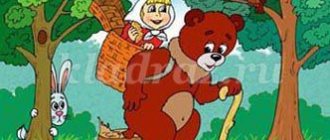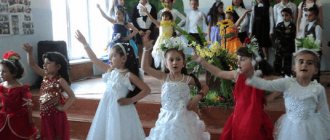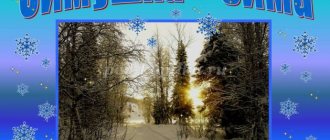Final game lesson in mathematics in kindergarten. Senior group
Summary of the final lesson on elementary mathematical concepts and speech development in the senior group “Journey to the Land of Knowledge”
The dominant educational area is cognitive development. The purpose of direct educational activities : To improve the knowledge of children acquired over the year. Objectives: Educational:
To identify the level of acquired knowledge and ideas of children during the school year.
To consolidate and expand children's knowledge about the months, relating them to the seasons. - activate children's vocabulary. - teach sound development, dividing words into syllables and sounds - continue to teach how to solve simple arithmetic and logical problems; - to develop counting skills, the ability to name neighbors of numbers - Continue work on activating and clarifying children's vocabulary - improve knowledge of the sequence of parts of the day, days of the week. Developmental:
- develop children's interest in independently solving problem situations.
-develop fine motor skills, cognitive processes; -develop logical thinking, ingenuity, intelligence, resourcefulness, memory; - practice finding patterns; Educational:
-promote the emotional well-being and comfort of children, -develop self-control over speech, -cultivate a friendly attitude towards each other;
develop independence, the ability to understand a learning task and independently carry it out; - cultivate interest in the activity. Types of children's activities: Didactic games: “Load the groceries on the train”, “Find a place and name the neighbors”, “Add a word”, “Photograph”, solving examples, reading and composing a word. Materials and equipment : For each child, sheets of paper with geometric shapes (drawn with dots), simple pencils; cards with numbers and letters (daisy); pictures with products, train with carriages; set of geometric shapes; “daisy flower” with examples, envelopes with tasks, surprise - candy. Integration of educational areas: Social communicative development, physical development.
Preliminary work: d/game “Name the neighbors” for consolidating neighboring numbers, “Name the week” - consolidating temporary concepts and names of days of the week, “Guess the figure” - consolidating geometric figures, mathematical dictations for orientation in space for attention and memory. Reading syllables, words and their division into syllables and sounds. Progress of continuous educational activities:
Part I Organizational moment. Guys, let's say hello to the guests. Look at the guests - they smiled. Look at each other - smile. Well done! Now listen to me carefully. Today we have an unusual activity, we will take you on a journey to the “Land of Knowledge”. A surprise awaits you there, but you can find it if you pass all the tests. The tasks will be difficult but interesting. After completing all the tasks, you will find out what surprise awaited you. You are ready? Good luck then! And to find out what tasks await you, you need to guess the riddle: What kind of miracle is in the clearing. In a marvelous white sundress. And a green shirt, With a yellow spot... (Chamomile) That's right, it's a chamomile, but where is it hiding? (children find a chamomile). Look, there are examples on chamomile petals. We need to solve the example and then we will find out what task awaits us, are you ready? II Main part. - Let's tear off the first petal with an example whose answer = 1 (1+0) - solve it. — On the table we find envelope No. 1 with tasks: — Let’s make a semicircle and answer the questions: Task 1: — Guys, name the seasons. - How many months are there in a year? (12). - What is the first month of the year - what is the last month of the year - What time of year is it now? (spring). - What month is it now? (May). - What are the spring months? - How many days are there in a week? (seven). — What day of the week after Wednesday? Before Tuesday? - Name the days of the week in order. - What parts of the day do you know? - Name the parts of the day in order. -Which comes first, evening or morning? Well done! Task 2: We tear off the second petal with example =2 (1+1) and look for an envelope with the number 2. Game “Find a place and name the neighbors” Here are cards with numbers. You are marching in a circle to the music, when the music ends, you must quickly line up in order, starting from me. Hold the cards like this (I show them so that the children can see your number. (children complete the task). Number 6, name your neighbors; number 3, name your neighbors; number 9, name your neighbors. Well done, you completed the task. 3rd task: Petal with example =3 (4-1) take an envelope with the number 3 Game “Load the groceries on the train" Children are divided into two teams, cards with pictures are distributed to the children. On the board for each team is a “train of three cars”: the first car with three windows , the second carriage - 4 windows, the third carriage - 5 windows.. The teacher invites the children to “load” food into the train (cheese, flour, sugar, etc.) In this case, the number of sounds in the words - the names of the products - must correspond to the number of windows in the carriage. (Whose team is faster, then check with each other.) Task 4: Petal with an example = 4 (2 + 2) take an envelope with the number 4 “Guess the geometric figure” (I hand out to the children pieces of paper depicting geometric figures with dots) Guys, turn over the pieces of paper and say what is depicted there (geometric figures). And to find out for sure, let’s connect the dots (children complete the task, after completing the task I ask 3-4 children “what figure did you get?”) Task 5: petal with example = 5 (4+1) “Guess the geometric figure” (I hand out the leaves to the children with the image of geometric figures in dots) Guys, turn over the leaves and say what is shown there (geometric figures). And to find out for sure, let’s connect the dots (children complete the task, after completing the task I ask 3-4 children “what shape did you get?”) Task 6: petal with example = 6 (7-1) Warm-up 1, 2, 3, 4, 5 We all know how to count, we also know how to relax. Let's put our hands behind our backs. Let's raise our heads higher and breathe easily... One, two! – head higher, Three, four – arms wider. Five, six - sit down quietly. One - rise, pull yourself up, Two - bend, straighten up Three - three claps of your hands, three nods of your head. At four - arms wider, at five - wave your arms, at six - sit quietly at the table. Task 7: a petal with an example of a 5+2 task is called “photographer” - You need to look carefully at the image, take a photograph of it - remember it and lay out exactly the same one from geometric shapes. (look, remember and do it) Guys, what kind of figure does (trapezoid) look like? Guys, we have passed all the tests, all our chamomile petals have run out, but it’s just not clear where the treasure is? - Let's look at our flower carefully. Under the center of the flower, the children find a riddle: “Oh, you sweet treats, why are you hiding in pieces of paper? If it doesn't work, they'll find it! They are giving you away.” What do you think this could be? (candies). Now you know what surprise awaits you. To find a surprise, you must take 3 steps forward, 5 steps to the right, etc. ... (children find a surprise). Did you enjoy looking for surprises and completing tasks? Guys, which task did you like the most? Which one turned out to be the most difficult? (Children's answers)
We recommend watching:
Summary of GCD for the development of mathematical concepts in the senior group of kindergarten GCD for mathematics in the senior group based on Perrault's fairy tale “Little Red Riding Hood” Summary of GCD for FEMP in the senior group Lesson in mathematics in the senior group. Abstract
Similar articles:
Summary of a mathematics lesson in the senior group of kindergarten. Geometric figures
Summary of a lesson on FEMP in the senior group of a preschool educational institution on the topic: Width of objects
Summary of a lesson on FEMP in the senior group of a preschool educational institution on the topic: Measuring length
Abstract of GCD in mathematics in kindergarten in the senior group on the topic “Ball, cube”
Abstract of GCD in mathematics in kindergarten in the senior group. Length, height, width of objects





